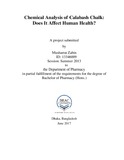| dc.contributor.advisor | Neelotpol, Dr. Sharmind | |
| dc.contributor.author | Zabin, Musharrat | |
| dc.date.accessioned | 2018-01-30T05:58:08Z | |
| dc.date.available | 2018-01-30T05:58:08Z | |
| dc.date.copyright | 2017 | |
| dc.date.issued | 2017-06 | |
| dc.identifier.other | ID 13346009 | |
| dc.identifier.uri | http://hdl.handle.net/10361/9288 | |
| dc.description | This project report is submitted in partial fulfilment of the requirements for the degree of Bachelor of Pharmacy, 2017. | en_US |
| dc.description | Cataloged from PDF version of project report. | |
| dc.description | Includes bibliographical references (page 42-44). | |
| dc.description.abstract | Consumption of geophagic soil by mankind is an enigmatic and convoluted fact. The fact has fecundity to produce huge conventional reasons for consuming the soil but still those are considered as elusive. Indigence naturally obstructs people to get proper level of nutrition and they try to replenish their lost nutrition by consuming geophagic soil. Studies relevant to this fact have illuminated that, most of the people are unwitting of the deleterious effects of consumption of soil. The compendium of several studies have erupted plethora of information about the dreadful effects of soil consumption. The paramount cause of providing lamentable effects is presence of trace elements and heavy metals. Superfluous ingestion of elements with the soil shows temerity to impair the balance of macromolecules in the body. The perennial and corrosive effects suggest iron deficiency, growth retardation, heavy metal exposure etc. All of these facts provoked a solicitous analysis of trace elements and heavy metals for Calabash chalk soil that was collected from Sylhet which is geographically located in Northeastern part of Bangladesh. Trace elements and heavy metals were analyzed by Atomic Absorption Spectroscopy which includes potassium (K), Manganese (Mn), Copper (Cu), Zinc (Zn), Iron (Fe), Chromium (Cr), Cadmium (Cd), Arsenic (As), Lead (Pb). The factual deduction of the analysis had shown the presence of Lead (pb) in significant amount 19.26 ppm that has plausible harmful and toxic effect in human body. In the context of presence of heavy metals, the soil contains another toxic element named Arsenic (As). This heavy metal’s amount in the soil is represented as 4.57 ppm from the analysis that certainly can threat human health in the relevance of toxicity. Study result has given a platform to peruse and to discuss the salutary and terrible effects for excessive soil consumption. | en_US |
| dc.description.statementofresponsibility | Musharrat Zabin | |
| dc.format.extent | 45 pages | |
| dc.language.iso | en | en_US |
| dc.publisher | BRAC University | en_US |
| dc.rights | BRAC University project reports are protected by copyright. They may be viewed from this source for any purpose, but reproduction or distribution in any format is prohibited without written permission. | |
| dc.subject | Chemical analysis | en_US |
| dc.subject | Calabash chalk | en_US |
| dc.subject | Human health | en_US |
| dc.title | Chemical analysis of calabash chalk: does it affect human health? | en_US |
| dc.type | Project report | en_US |
| dc.contributor.department | Department of Pharmacy, BRAC University | |
| dc.description.degree | B. Pharmacy | |

